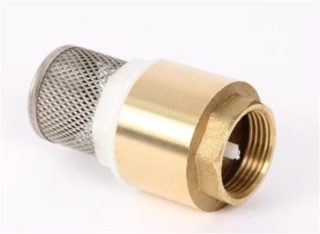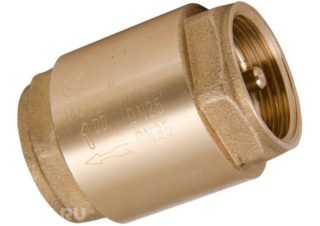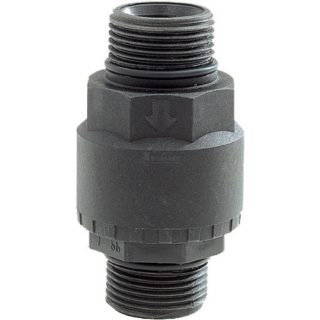The autonomous water supply system for country houses includes not only pumps and piping. In addition, the water supply system is completed with protective pipeline fittings, a prominent representative of which is a check valve for a pumping station.
Types and purpose of the check valve

The main purpose of the valve is to maintain the pressure inside the water supply network in the optimal mode. In particular, its task is to prevent the water that the pump pumped into the pipeline from flowing back.
This type of valves is divided into two types:
- Bottom valve. Installed in front of a pump that pumps water from a well or well. The device is placed in water.
- Trunk. Cut the water pipe before or after the pump.
There is a classification of valves, which are based on purely design features of the device. The main difference is the form and principle of the working body.
Bottom valve
There are two types of bottom valves on the market. Spring loaded option - a cylindrical device, inside which a disk is installed. It is supported on top by a spring. On the reverse side, the disc rests against the seat - a hole formed by a protruding edge located along the inner diameter of the device.
When water is injected, its pressure rises, which presses on the disk from below. The spring is compressed, the disc opens a gap between itself and the seat. As soon as the pressure decreases, that is, the pump stops pumping water, the spring expands and presses the disc against the edges of the seat.
The second modification is folding... One or two flaps are located inside the disc-shaped device. They open under the pressure of water from below and close when the pressure drops to zero. The flaps themselves are attached to the inner surface of the valve with devices that resemble door hinges. In doing so, the flaps are precisely matched to the seat size to avoid fluid leakage from the pipe.
According to the method of attachment, both bottom valves are divided into two groups, which are based on the method of attaching the device to a pipe or pump. The connection is made by thread or by means of flanges. In domestic pumping installations, a threaded connection is used.
A strainer must be installed in front of the bottom valve. The device itself is mounted in the direction indicated by the arrow on the body of the device. The distance from the check valve to the bottom of the well or well should not be less than 0.5 m, to the water mirror not less than 0.3 m.
Speaking about the place of installation of the check valve on a submersible pump, it is necessary to indicate that there are pumping units on the market, inside of which a strainer is already installed. Therefore, the filter element is not mounted in front of the valve. Pipe fittings are often installed after the pump.
Trunk

In this category, there are several types of check valves, which differ from each other in the locking device and the principle of its operation. But the purpose of the devices is the same - to ensure the movement of liquid in one direction and not to allow the formation of a reverse current. The working body (locking device) opens under the action of moving water and closes more often under the action of its own weight or a spring.
The shut-off element in the design of the check valve can move horizontally (along the axis of movement of water), vertically (perpendicular to the water flow) or at an angle. When installing the device, it is necessary to monitor not only the correct position of the arrow on the body, but also the location of the cover. Manufacturers offer four types of check valves, which differ in the operation of the shut-off element.
Spring loaded the device is a valve structure in which the valve moves vertically. At the same time, it is spring-loaded from above, therefore it works like a spring-loaded bottom element.
Swivel a model is a structure in which the locking device moves in the direction of water movement. It is a disc that is vertically positioned and hinged to the edge of the seat. In this case, the disc opens up and falls under its own weight.
Disk option - a cylindrical device, inside which a vertical disk is installed. On the one hand, it is spring loaded. The locking device moves in the direction of water movement.
Ball the model is an angle-type structure that is installed only on a vertical pipeline. Such a check valve is similar to a tee, the outlet of which is tightly closed. It is in it that the ball will mix. When the pump is not running, the ball is located at the bottom of the structure. The pressure begins to increase, the water presses on the ball from below, and it moves to the outlet of the device, opening the main line. As soon as the pressure drops, the ball rolls back into place along the inclined plane of the outlet, blocking the section of the water main.
In the design of low-power autonomous water pipelines, which are most often organized in suburban areas, a ball or rotary model is usually used. They have small overall dimensions due to the absence of a spring and a long stroke of the locking device.
Main check valves can be attached to pipes of an autonomous water supply network in four ways. Each has its own advantages and disadvantages.
- Couplings - devices with an internal thread on each side.
- Flanged - on the nozzles they have flanges that are connected to the counterparts welded to the water pipe.
- Wafer-type - disk-type models, which are mounted between the pipeline flanges and attached to them with four studs, that is, the valve is clamped by flanges.
- Fatty - using electric welding, they are attached directly to the pipes of the water supply network.
In domestic autonomous water pipelines, coupling-type check valves are mainly used. They are easier to mount and dismantle. The repair of this device is quite simple.
Manufacturing material

The plumbing fittings market offers a fairly wide selection of check valves in terms of the material from which they are made. The main requirement is high strength and corrosion resistance:
- cast iron;
- stainless steel;
- bronze;
- brass;
- plastic.
The ideal option is stainless steel. But products made from it are expensive. Cast iron models are the most bulky. They are practically not used in household networks. The most popular are brass. These valves do not corrode when exposed to water, the price is reasonable. Plastic also does not corrode, but experts recommend installing them on pressure pipes with low pressure.
Locking devices are made of stainless steel, plastic or aluminum. In spring-type valves, the most vulnerable node is the spring. It most often fails, therefore, a stainless steel part is installed in almost all devices.
Today, many manufacturers are trying to reduce the cost of their products in order to make them competitive. Therefore, you can find combined models on the market. For example, a brass valve with a stainless steel or plastic shut-off device.All shut-off valves are tested and tested for the tightness of the structure, which is confirmed by certificates, therefore the combined modifications comply with the standards and requirements of GOST.
Installation features
Installation conditions for non-return valves are the same as for other types of valves. The main requirement is to carry out the installation correctly so that the arrow on the device body is located in the direction of the water flow. Other conditions:
- free access to the valve for maintenance and repair;
- strictly ensure that the devices are installed horizontally or vertically;
- a check valve for a well must be completed with a filter.
The valve in the system of an autonomous water supply network plays an important role. With its help, the pump remains full all the time, there is no need to fill it at start-up. This increases the usability of the water supply network.








